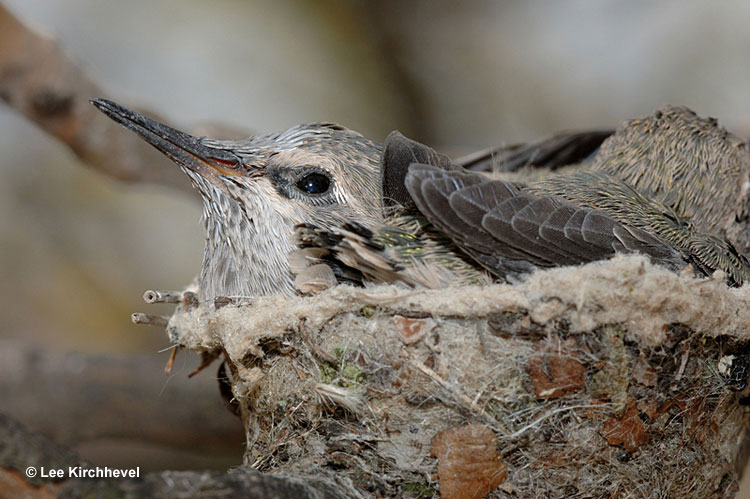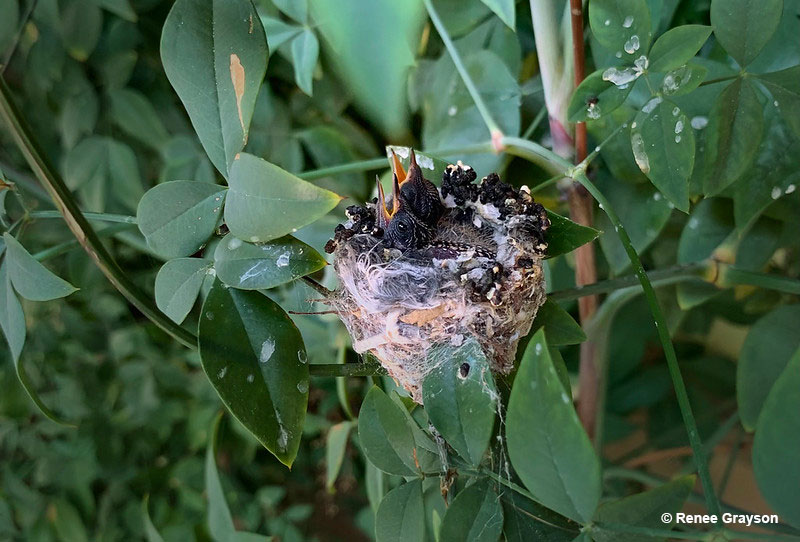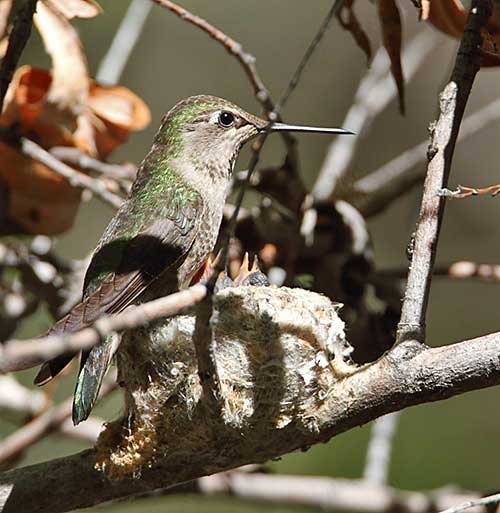
What’s a hummingbird nest like? These shining creatures may live in the avian fast lane, but they still make nests!
They also lay tiny eggs and, just like so many other birds, raise their young. In this article, we’ll talk all about the nests and nesting habits of hummingbirds.
On this page
Hummingbird Nests
In North America, species like the Ruby-throated Hummingbird start nesting in May, but many species nest at other times. No matter where hummingbirds live, they usually coincide their nesting season with flowering plants. For Ruby-throated Hummingbirds, this plant tends to be the wild Flowering Columbine.
In the case of the Anna’s Hummingbird, this species nests during the wet winter months, while the Costa’s Hummingbird nests in early spring.
Related: How to attract hummingbirds?
Female hummingbirds pick the nest site (usually in shrubs) and do all of the nest construction. Most hummingbirds use spider silk and plant fibers as threads to bind their nest together. They usually build their tiny nests on thin branches but can also make them on roadside cables, cacti, and even clotheslines! Typical nesting sites are shaded by leaves, over streams, or other spots that offer protection from predators.
Males, however, play no role in the incubation period.

Hummingbirds make their nests out of spider silk, thistles, dandelions and other bits of soft plant matter
Hummingbirds make their nests out of spider silk, thistles, dandelions and other bits of soft plant matter. They use these soft materials to help insulate the eggs, and so the nest can expand to accommodate quickly growing nestlings. These tiny birds also camouflage their nests with lichen and bits of moss.
Most hummingbird nests are around the same size as a golf ball, or 1.5 inches in diameter. They can also be anywhere from a few feet to 60 feet above the ground and can be near or somewhat far from food sources.
What does a hummingbird nest look like?
Hummingbird nests aren’t the easiest things to spot, but if you know what to look for, you can find them!
Look for a small, pale, mottled lump on a thin branch or other spot. If you see a hummingbird fly in or sitting on it, you have found a hummingbird nest!
Hummingbird nests are around the same size as a golf ball, are usually 1.5 inches in diameter, and can blend in very well with pale tree branches. They are anywhere from a few feet to 60 feet above the ground and can also be near or somewhat far from food sources.
And no, hummingbirds won’t mate for life. They mate just for minutes.

Anna’s Hummingbird on the nest
Dangers
Hummingbird nests are well camouflaged for very good reasons. Many animals love to find bird nests because eggs and nestlings act as easy, highly nutritious food. Hummingbird nests are no exception and can be preyed on by a wide variety of predators.
In common with other birds, their nests are vulnerable to jays and crows but they can also be attacked by woodpeckers and some other birds. Although these nest predators would probably prefer nests with bigger eggs and young, if they can spot a hummingbird nest, they won’t pass up an easy free meal.
The same goes for small snakes, squirrels, mice, and other animals that prey on hummingbird nests.
Kestrels and Merlins can also prey on nesting hummingbirds but are more likely to attack female hummers than the eggs or nestlings. However, when the baby hummingbirds leave their nest, they can become easy targets for small raptors, domestic cats, and other animals.
Related: How long do hummingbirds live?
Fortunately, hummingbird nests are hard to find because they are so small and camouflaged. Nesting over streams and in cactus plants also protects some nests from predators. As for the fledglings, they quickly master flight and become adept at escaping from potentially dangerous situations.
Some Facts About Hummingbirds and Their Nests
- The Blue-throated Mountain-Gem (also known as the Blue-throated Hummingbird) builds its nest under rocky overhangs and other sheltered spots. For this reason, we also find their nests on wires, chains, and other structures at and inside sheds and cabins.
- When choosing a site for nesting, female hummingbirds often land on a branch or other spot over and over. She tests the potential nest site for stability and to see if it supports her weight.
- Hummingbirds use spider webs and soft plant matter for their nests but can also make use of small feathers, fuzzy materials, and hair.
- Nesting material can be a scarce resource. During the nest-building process, female hummingbirds frequently steal nesting material from other hummingbirds.
- Hummers often reuse the same nest site, year after year. However, they always use fresh material to refurbish their nest.
- The Tropical Hermit Hummingbirds make highly camouflaged, elongated nests that are built under broad, banana-like leaves.
- The Calliope Hummingbird often uses a dead pinecone for the base of its nest. That way, the nest itself looks like a random, old pinecone.
- Broad-tailed Hummingbirds pick nesting sites with some form of good, overhanging protection, and a quick escape route. The nest structure and materials are also adapted to keeping the eggs warm in cold temperatures.
Frequently Asked Questions
Where do hummingbirds nest?
Hummingbirds nest on thin branches, wires, clotheslines, and many other situations, usually with some overhead cover.
When do hummingbirds nest?
Hummingbirds nest when they have lots of food for their young. This varies by species with most nesting in spring. However, Anna’s Hummingbirds nest during the wet winter months.
Do hummingbirds reuse their nests?
Some hummingbirds reuse their nests, but generally, they build a new nest every year.
How many times a year do hummingbirds lay eggs?
Most hummingbirds lay eggs once per year. However, Ruby-throated Hummingbirds, Black-chinned Hummingbirds, and some other species lay eggs twice per year.
What do hummingbirds’ eggs look like?
Hummingbird eggs are small, plain white eggs around the size of a coffee bean.
How long does a mother hummingbird sit on her eggs?
A mother hummingbird sits on her eggs for 15 to 20 days.
Do hummingbirds leave their eggs at night?
No, hummingbirds do not leave their eggs at night. They incubate the eggs all night long to keep them warm.
Read next: Everything you need to know about hummingbird eggs

